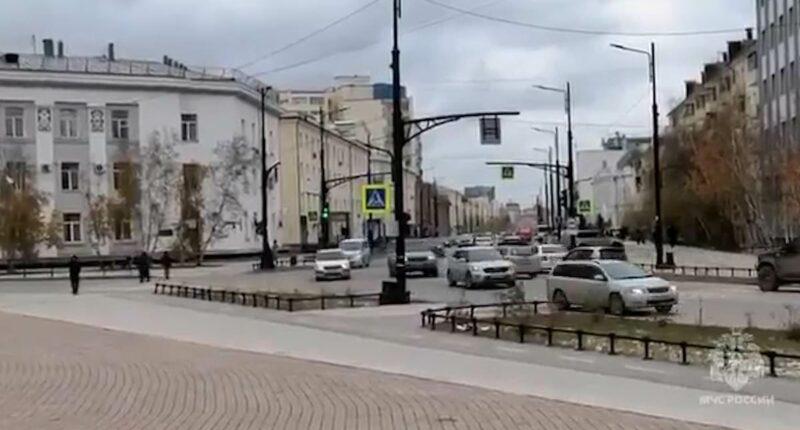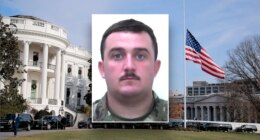Share this @internewscast.com
Russia has conducted a comprehensive nuclear war drill across the nation, heightening concerns about the potential for World War III. This occurred just a day after Trump cautioned Putin that the U.S. boasts more nuclear weapons than any other nation.
Sirens echoed throughout Russia’s 11 time zones, coupled with loudspeaker messages, all as part of a system meant to alert the population in case of war or a chemical or biological threat.
The tests interrupted TV and radio broadcasts, educating Russians on the proper steps to take should the sirens signal a real emergency, and it is equally applicable during unusual weather events.
Citizens were advised through the broadcasts to ‘stay calm and refrain from panic’, ‘tune into the TV, or any public channel, or radio for further announcements’ if the sirens go off.
The drill came after US president Donald Trump boasted about his country’s nuclear capabilities, in a chilling warning to Putin.
Addressing a gathering in Quantico, Virginia, yesterday, he remarked: ‘Honestly, if it comes to that, we possess more [nuclear weapons] than anyone else. Ours are superior, ours are newer [weapons].’
‘But it’s something we don’t ever want to even have to think about.’
Trump also remarked that Russia had recently posed a ‘mild threat’ to the US. He disclosed that a nuclear submarine was dispatched after Dmitry Medvedev seemed to issue a warning to the US in August.
‘Based on [Medvedev’s] mention of nuclear… I moved a submarine or two over to the coast of Russia – just to be careful, because we can’t let people throw around that word’, Trump told supporters.

Russian citizens heard alarms that will be used to warn them about the outbreak of nuclear war or other disasters

It comes as Putin continues to clash with the West over recent provocations across NATO’s eastern flank
Trump and Medvedev were embroiled in a war of words on social media, where Putin’s henchman told the US leader to remember that Moscow owned Soviet-era nuclear strike capabilities.
Russia’s drill came as Putin’s government continues to highlight the threat of war with the West, including the risk of nuclear conflict.
Reporting on the exercise, the defence ministry’s TV channel Zvezda said: ‘A scheduled test of the warning systems was conducted. Radio and TV broadcasts were also suspended for one minute.’
Mash news outlet stated: ‘Sirens are still sounding in cities, but don’t be alarmed. Everything is fine. This is planned work.’
In the remote Yamal-Nenets autonomous region straddling the Arctic Circle, the siren sounded with a message stating: ‘Attention! The integrated emergency warning system is being tested!’
In Volgograd and Krasnodar, some locals said that the noise of traffic drowned out the alarm. Some residents in Moscow denied hearing the siren.
Some people expressed criticisms of the alarm. ‘First the siren blared, and only then did they announce over the loudspeaker that it was a drill and to remain calm,’ said one.
Another critic said: ‘First the siren blared, and only then did they announce over the loudspeaker that it was a drill and to remain calm.’
A fourth said: ‘You can hear the sirens, but what the announcer says next is completely incomprehensible. You can’t make out a single word.’ The sirens are usually tested twice a year.
Tensions between the West and Vladimir Putin have surged after a series of Russian provocations on NATO’s eastern flank, with allied leaders now debating whether to lower the threshold for shooting down hostile aircraft.

Donald Trump departs after addressing senior military officers in Virgina on September 30. At a rally, he warned Russia that the US had more nuclear weapons than any other countries

Russian fighter jet flying over Estonia’s airspace. In recent weeks, Putin has launched several provocations across Europe, sparking fears of a global conflict

Drones spotted at over the runways of Scandinavian airports were linked to Putin, with several nations criticising the Russian leader
In recent weeks, Russian drones and fighter jets have entered the skies above Poland, Romania and Estonia, while suspicious drone activity has been reported at military sites and airports in Denmark, Lithuania, Sweden and Norway.
Latvian President Edgars Rinkēvičs told Estonian broadcaster ERR that NATO must shift from ‘air policing’ to full ‘air defence,’ warning that simply escorting intruding jets is no longer sufficient.
His call follows one of the most serious incidents in decades, when about 20 Russian drones flew into Poland on September 10, some heading towards the Lask air base where US F-35s are stationed.
Admiral Giuseppe Cavo Dragone, chairman of NATO’s military committee, confirmed that tougher rules of engagement are being considered, though he cautioned it was ‘still premature.’
NATO’s secretary-general Mark Rutte has said shooting down intruders would be an appropriate response ‘if so necessary,’ while Britain, France and Germany have warned Moscow the alliance’s threats are not empty.
Poland has also threatened to shoot down any hostile objects in its airspace, leading a senior Russian diplomat to caution that there would be war if any Russian aircraft were downed.
Meanwhile, frontline states are pressing ahead with plans for a protective ‘drone wall.’




